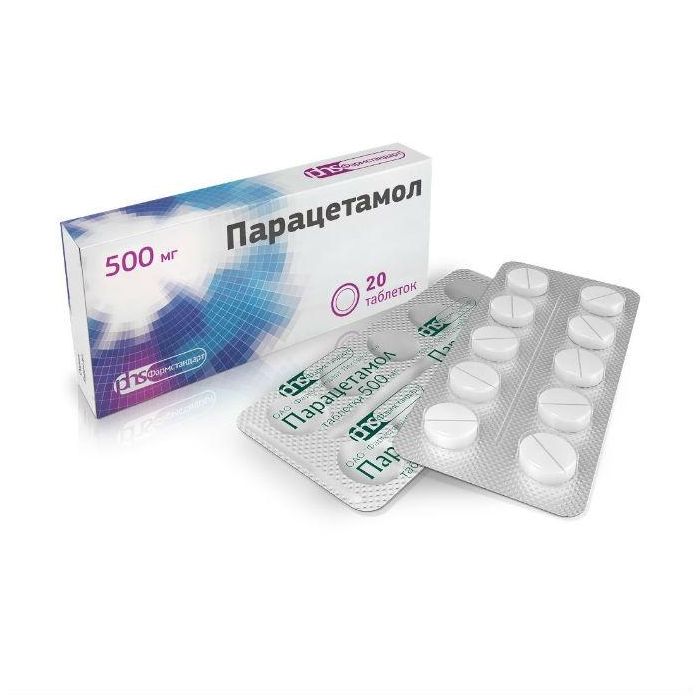Paracetamol | Paracetamol tablets 500 mg 20 pcs.
Special Price
$26
Regular Price
$33
In stock
SKU
BID494457
Packaging
20 pcs.
Indications
Pain syndrome of mild to moderate intensity of various origins (including headache, migraine, toothache, neuralgia, myalgia, algodismenorea pain due to injuries, burns). Fever for infectious and inflammatory diseases.
Contraindications
hypersensitivity to paracetamol or any other ingredient of the
drug severe liver or kidney dysfunction
childhood (up to 3 years)
Caution: use with caution in case of benign hyperbilirubinemia (including hepatitis virus) , alcoholic liver damage, glucose-6-phosphate dehydrogenase deficiency, alcoholism, pregnancy, lactation, in old age. The drug should not be taken simultaneously with other paracetamol-containing drugs.
Use during pregnancy and lactation
Paracetamol crosses the placental barrier. To date, there has been no adverse effect of paracetamol on the fetus in humans.
Paracetamol is excreted in breast milk: the content in milk is 0.04-0.23% of the dose taken by the mother.
If you need to use paracetamol during pregnancy and lactation (breastfeeding), you should carefully weigh the expected benefits of therapy for the mother and the potential risk to the fetus or child.
In experimental studies, the embryotoxic, teratogenic and mutagenic effects of paracetamol have not been established.
Composition
Composition per tablet
active substance: paracetamol - 500 mg
excipients: potato starch, croscarmellose sodium (croscarmellose sodium), povidone (low molecular weight polyvinylpyrrolidone medical acid).
Dosage and administration
Inside or rectally in adults and adolescents weighing more than 60 kg, a single dose of 500 mg is used, the frequency of administration is up to 4 times / day. The maximum duration of treatment is 5-7 days.
Maximum doses: single - 1 g, daily - 4 g.
Single doses for oral administration for children aged 6-12 years - 250-500 mg, 1-5 years - 120-250 mg, from 3 months to 1 year - 60-120 mg, up to 3 months - 10 mg / kg. Single doses for rectal use in children aged 6-12 years - 250-500 mg, 1-5 years - 125-250 mg.
Frequency of use - 4 times / day with an interval of at least 4 hours. The maximum duration of treatment is 3 days.
Maximum dose: 4 single doses per day.
Side effects of
At recommended doses, the drug is usually well tolerated. Paracetamol rarely causes side effects. Allergic reactions can sometimes be observed (skin rash, itching, urticaria, Quincke edema), erythema multiforme exudative (including Stevens-Johnson syndrome), toxic epidermal necrolysis (Lyell's syndrome), dizziness, nausea, epigastric pain, anemia, thrombocytopenia agranulocytosis insomnia. With prolonged use in large doses - increases the likelihood of impaired liver and kidney function, as well as the hematopoietic system.
From the digestive system: nausea, epigastric pain, increased activity of liver enzymes, hepatonecrosis. From the endocrine system: hypoglycemia. If unusual symptoms occur, consult a doctor.
Drug Interaction
When used in conjunction with inducers of microsomal liver enzymes, agents with hepatotoxic activity, there is a risk of increased hepatotoxic action of paracetamol.
When administered with anticoagulants, a slight or moderate increase in prothrombin time is possible.
In combination with anticholinergic agents, paracetamol absorption may be reduced.
With simultaneous use with oral contraceptives, the excretion of paracetamol from the body is accelerated and its analgesic action may be reduced.
When used with uricosuric agents, their effectiveness decreases.
Simultaneous use of activated carbon reduces the bioavailability of paracetamol.
Diazepam excretion may be decreased when co-administered with diazepam.
There are reports of the possibility of enhancing the myelodepressive effect of zidovudine when co-administered with paracetamol. A case of severe toxic liver damage is described.
Cases of toxic effects of paracetamol when co-administered with isoniazid have been described.
When used with carbamazepine, phenytoin, phenobarbital, primidone reduces the effectiveness of paracetamol, which is due to an increase in its metabolism (processes of glucuronidation and oxidation) and excretion. Cases of hepatotoxicity with the simultaneous use of paracetamol and phenobarbital have been described.
When using cholestyramine for less than 1 h after the administration of paracetamol, the absorption of the latter may be reduced.
With simultaneous use with lamotrigine, the excretion of lamotrigine is moderately increased from the body.
When used with metoclopramide, it is possible to increase the absorption of paracetamol and increase its concentration in blood plasma.
When co-administered with probenecid, paracetamol clearance may be reduced with rifampicin, sulfinpyrazone may increase paracetamol clearance due to increased hepatic metabolism.
When co-administered with ethinyl estradiol, the absorption of paracetamol from the intestine increases.
Overdose
Signs of an overdose of paracetamol - nausea, vomiting, stomach pain, paleness of the skin, anorexia. After a day or two, signs of liver damage are determined. In severe cases, liver failure and coma develops. A specific antidote for paracetamol poisoning is N-acetylcysteine.
Symptoms: pallor of the skin, anorexia, nausea, vomiting, hepatonecrosis (the severity of necrosis directly depends on the degree of overdose). If overdose is suspected, seek medical attention immediately. The toxic effect of the drug in adults is possible after taking more than 10-15 g of paracetamol: increased activity of hepatic transaminases, an increase in prothrombin time (12-48 h after administration) a detailed clinical picture of liver damage manifests itself in 1-6 days. Rarely, impaired liver function develops rapidly and may be complicated by renal failure (tubular necrosis).
Treatment: the patient should do gastric lavage during the first 4 hours of poisoning, take adsorbents (activated charcoal) and see a doctor, the introduction of donors of SH-groups and precursors of synthesis of glutathione - methionine in 8-9 h after overdose and N-acetylcysteine - after 12 h. The need for additional therapeutic measures (further administration of methionine, in / in the introduction of N-acetylcysteine) is determined depending on the concentration of paracetamol in the blood, as well as the time elapsed after its administration.
Storage conditions
Store in a dry, dark place and out of the reach of children, at a temperature not exceeding + 25 РC.
Shelf suitability
3 Year
Deystvuyuschee substances
Paracetamol
pharmacy leave terms without a prescription
dosage form
dosage form
tablets
Pharmstandard-Leksredstva, Russia
Submit your review to Earn 10 Reward Points click here to login
Write Your Own Review

